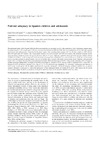Identificador persistente para citar o vincular este elemento:
https://accedacris.ulpgc.es/jspui/handle/10553/44804
| Título: | Nutrient adequacy in Spanish children and adolescents | Autores/as: | Serra-Majem, Lluís Ribas-Barba, Lourdes Pérez-Rodrigo, Carmen Aranceta Bartrina, Javier |
Clasificación UNESCO: | 32 Ciencias médicas 3206 Ciencias de la nutrición |
Palabras clave: | Nutrient Adequacy Recommended Nutrient Intake Children Adolescents Nutrition Survey, et al. |
Fecha de publicación: | 2006 | Publicación seriada: | British Journal of Nutrition | Conferencia: | 6th Congress of the Spanish-Society-of-Community-Nutrition | Resumen: | The nutritional intakes of the Spanish child and adolescent population are presented, as well as the population at risk of inadequate nutrient status. A random sample of 3534 people aged 2-24 years were interviewed between 1998 and 2000. Interviews included two 24 h recalls and a general questionnaire and anthropometric evaluations for the entire sample. After excluding under-reporters (18 center dot 7 %), the final sample was 2855 individuals (1348 males and 1507 females). The average intake of energy was 9543 kJ in males and 7804 kJ in females, with important variations seen by age group. Energy intake increased with age in both sexes until 14-17 years, which also applied to almost all of the nutrients studied, with the exception of vitamin C. A decreasing trend in the percentage of energy from carbohydrates was seen in both sexes. At the low socioeconomic level, it was observed that all nutrient intakes were less favourable when compared with higher socioeconomic levels. Nutrients with associated intakes below one-third of the Spanish recommended nutrient intake (RNI) included vitamin D (42 % of the sample) and folate (10 % of females), and the percentages falling below two-thirds of the RNI corresponded to: vitamin D (97 %), vitamin A (60 %), vitamin E (54 %), folate (58 % of females), Fe (23 % of females), vitamin C (8 %), Mg (4 center dot 5 %), Ca (5 % of females) and vitamin B-6 (5 % of females). Adolescents aged between 14 and 17 years was the group with the highest nutritional risk, especially among girls. Nutritional adequacy in Spanish children was, in general, adequate, although it is necessary to analyse the implications of high inadequate intakes of vitamins D, E and A, which means that the current recommended intakes should be reconsidered. It should be noted that folate levels should be doubled in the near future. | URI: | https://accedacris.ulpgc.es/handle/10553/44804 | ISSN: | 0007-1145 | DOI: | 10.1079/BJN20061701 | Fuente: | British Journal of Nutrition [ISSN 0007-1145], v. 96 (sup. 1), p. S49-S57, (Agosto 2006) |
| Colección: | Actas de congresos |
Los elementos en ULPGC accedaCRIS están protegidos por derechos de autor con todos los derechos reservados, a menos que se indique lo contrario.
